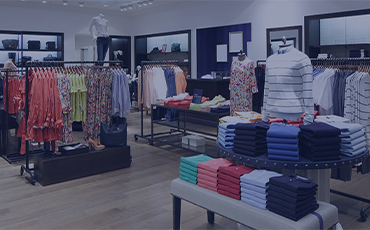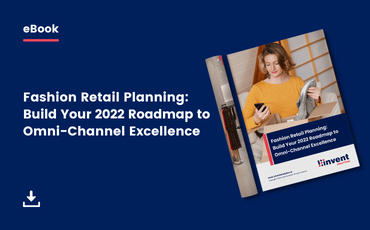
Omni-Channel Choices for Retailers' Success Today and Tomorrow
Game-changers in Retail: An Interview with Felipe Caro, Professor of Decisions, Operations and Technology Management UCLA Anderson School of Management
In this Game-changers in Retail Series, we had the pleasure to sit down with Felipe Caro, Professor of Decisions, Operations and Technology Management. Felipe Caro leads UCLA Anderson's new M.S. in business analytics (MSBA). His well-documented collaboration with Zara spans almost a decade. In particular, the mathematical model Felipe Caro developed to support the decisions fast-fashion retailers face each clearance period resulted in increased revenues of 3-4 percent for Zara. He has won multiple awards and contributed significantly to the international academic literature on supply chain management.
In this interview, we caught up with Felipe Caro to talk about the importance of planning in fashion retail, the emergent trends in 2022, and how inventory optimization is pivotal to retailers’ success in the omni-channel space. He shared with us what he’s seeing in fashion retailing and what’s helping retailers to become more effective and successful.
Retailers are going through an omni-channel transformation. How do you see the changing retail dynamics?
Many omni-channel shopping trends were already present in the retail world, but Covid-19 has supercharged the pace of the transformation. The pandemic has changed the way the consumers interact with retailers. It accelerated and intensified the shift to digital.
As a result, consumers started shopping in new ways that maybe they wouldn’t have even tried two years ago. People got more used to omni-channel shopping and they are now comfortable using different channels as it suits them. This confirms that omni-channel retail is here to stay.
Secondly, I think that we’ll also see more business models in the retail industry. To meet the different kinds of needs and address niche markets or supply chain challenges that come up in omni-channel retailing, retailers will evolve their business models and operations. Some of these retailers will become successful players and some of them won’t even be big but they’ll still be able to satisfy a niche market.
What are the fundamentals of any retailer’s success in an omni-channel era?
I think to be able to answer this question; retailers need to go back to the basics of knowing who they are. In today’s retail world, there is still a positioning choice that each retailer needs to make. That includes where they’re going to be in terms of omni-channel. This is all about the strategy, and many retailers realize that it is very challenging to get omni-channel retailing right.
Today retailers have 3 different options
First, they need to decide whether they want to have an omni-channel offer or not. Some retailers will choose to become omni-channel, but others might stay away from having an omni-channel presence. And that means some will choose traditional brick-and-mortar retailing, and some others will be pure online businesses. Retailers can still have a successful business model by staying either in the physical space or just being pure online.
Option 1: Stay traditional
Sticking to the traditional retail strategy takes courage, but I think that Primark is a good example of those that have chosen to be mostly brick-and-mortar. They buy in large quantities in advance, offer their products at low prices, and do well.
Option 2: Become pure online
On the other hand, there are pure online retailers such as Amazon. We all know that Amazon was a winner during the pandemic mainly because they have been exploiting all their logistics capabilities and gaining market share by making sure that their products arrive at their customers’ doorstep in a short amount of time.
Option 3: Go omni-channel
And some retailers are in the middle. Those are the ones that have to make the omni-channel promise work. And that’s when they start thinking about how they do it successfully. Customers search for the products wherever they want, and get them wherever they want, but delivering this promise is a huge challenge.
At the end of the day, retailers need to find a positioning that is meaningful to their customers and then, of course, they should be able to deliver it. The ones that get omni-channel right leveraging the combination of stores and online presence will become the big players in the future.
What do you consider as the biggest inventory optimization challenges or opportunities in omni-channel retail?
Challenge 1: Assortment decisions
Some inventory optimization challenges have always been there and become harder in the omni-channel space.
For example: Making the right assortment decisions. Consumers expect more variety today, and assortment has always been challenging for retailers, but now online removes all the space constraints. Retailers can’t fit too many products in physical stores whereas at online stores there is no limitation. They can carry as many items as they want -at least in theory. Then the questions for retailers become: “Do you want to carry as many items as you want?” and “Which ones do you carry, or do you offer?” This is a classic assortment problem, but today it's significantly harder to solve.
Challenge 2: Forecasting and fulfillment
There is also a forecasting and fulfillment challenge. For omni-channel retailers, demand forecasting and fulfillment are connected. When omni-channel retailers are doing their forecast, they need to take into account not only in-store demand but also the online shopping demand.
This adds a layer of complexity to demand forecasting and once retailers make their forecast and commit some inventory to the stores, the next question becomes, “Do you keep this inventory in the stores for a customer that comes to the store buy that item, or do you use it to fulfill an online sale?”
We wouldn’t talk about these issues 10 or 20 years ago. Yet, these are the challenges that arise with omnichannel retailing.
How important do you think it is to have accurate, granular level demand forecasting?
Demand forecasting will always be the holy grail of retailing. It is what drives everything in retail, and it will continue to be extremely important. The thing is that it is almost impossible to get forecasting right. Therefore, I believe what matters is to keep records of the past to fix future mistakes and even turn them into opportunities. Let me give you an example. Let’s say a retailer made incorrect forecasting and ended up with excess inventory. Could they use that excess inventory to fulfill the online demand? Again, forecasting and fulfillment are two challenges that go hand in hand in omni-channel retailing.

What are your thoughts on forecasting new season demand for the new items?
Fashion retailers have no magic formula to get the forecasts completely accurate for an item that will be introduced to the market a year from now. But, of course, they can improve their forecasts by incorporating new information when it becomes available or by using ML and advanced regression models.
And once retailers accept that they can’t get forecasting 100% right, they can look at what else they can do.
Not risking too much
I have been collaborating with Zara for many years and I am obviously biased by how the company operates and how they approach these problems.
They think that forecasting is important, of course, and they have invested more in prescriptive and predictive analytics since our collaboration began. But even so, Zara is aware that they will never get forecasting absolutely right -especially when it comes to fashion items.
So they don’t risk too much on any fashion item. When it comes to buying decisions, they usually buy more or less the same quantity. They make many small bets.
Keeping assortment fresh
And for these fashion items, they play the game of rotating the assortment. Those items that do well stock out quickly. The items that don’t do well are removed from display, and another product is introduced.
There will always be hits and misses. The point is that even the misses shouldn’t stay in the store for too long. Zara keeps the assortment fresh, and this is an incentive for people to always come to the stores, and it creates that continuous traffic. They also use their learnings to make more informed products decisions in the next season.
Keeping lead times short
Another successful strategy that Zara uses is about keeping their lead times short. Obviously, the shorter the horizon, the more accurate the forecast is. When the pandemic hit, the demand slowed down at the beginning. Zara was able to reduce the amount of inventory immediately. And then stores were closed to foot traffic, people started to shop online, and demand increased again. At that time, Zara used the stores for online fulfillment.
This is a great example of being flexible and agile. Zara uses their short supply chain to adjust inventory levels based on whether the demand is going down or up. When the demand for fashion items goes down, they buy less. When demand is picking up again, they buy more. When their customers are mostly shopping online, they use the stores to do online fulfillment to get the product quickly to their customers.
What are the top 3 key elements or must-haves in successful inventory optimization today?
Allocation and replenishment
Successful allocation and replenishment are the number one must-haves for successful inventory management. I think there is no excuse to get that wrong these days. There are sophisticated ML-based advanced analytics solutions that are available for retailers today.
Initial allocation
The second key element to success is the initial shipment which is a little bit harder.
But I think it can still be done successfully with advanced tools that are available today.
Buying decisions
And the third one is deciding how much to buy -this is the most challenging one. But ideally, once retailers get the initial allocation and replenishment right, they can make pretty informed decisions on how much they should buy.

How important do you think it is to have a clear markdown and price optimization strategy in today’s retail world?
First, focus should be on getting the inventory decisions right. If retailers solve the 3 inventory management challenges I’ve mentioned (initial allocation, replenishment and buying) then they would be relying less on markdowns. That’s because they would be buying the right quantity, and then allocating and replenishing it in the best way possible.
So getting these 3 inventory decisions right make markdowns less important, which is already good. But there will always be leftovers, especially with the fashion items. And when I think of markdowns, I think of clearance. Clearance sales is a well-understood revenue management problem. Leveraging that is another must for retailers. They should use established models, and leverage analytics to the fullest.
What do you think will be the key trends shaping the retail industry in the coming years?
I see two key trends.
One, there will be more competition coming from different business models. Today we see pure online retailers such as Shein taking the fast fashion business model to an extreme where they introduce many new products daily and renew their assortments daily. They produce the products in small quantities. The products are affordable, and they ship anywhere in the world. Companies like Shein will challenge incumbent retailers such as Zara and H&M.
I think the companies that are dynamic in their decision-making will adjust to these new competitors, but others might not. And shoppers will favor new specialty brands such as Dechatlon. More specialized stores will become more common, and some will grow. Eventually, I believe the market will become more fragmented.
Second, there will be challenges on the environmental and social responsibility side. I hope this becomes very important in shoppers’ minds. The big brands will have to think and act on sustainability because they will be the first ones to receive any backlash about how responsible their supply chains are. Retailers should become more conscious about their impact on the planet.
Finally, what do you think should be the top inventory planning strategies for retailers to become the Omni-Channel Retail Champions of tomorrow?
Retailers leveraging the advantages of each channel and optimizing their portfolios can achieve success in the omni-channel space. I think of omni-channel as I think of financial portfolios. The most successful portfolio is the one that allocates the right amount to the different assets that have various risks and returns. The same logic applies to omni-channel. Whoever finds the sweet spot, the right combination between online and physical presence will stay ahead. The retailers that optimize their portfolio, their channels and how they reach to the consumer to provide the information and deliver the product will be the winners and omni-channel retail champions of tomorrow.
Thank you Felipe.




